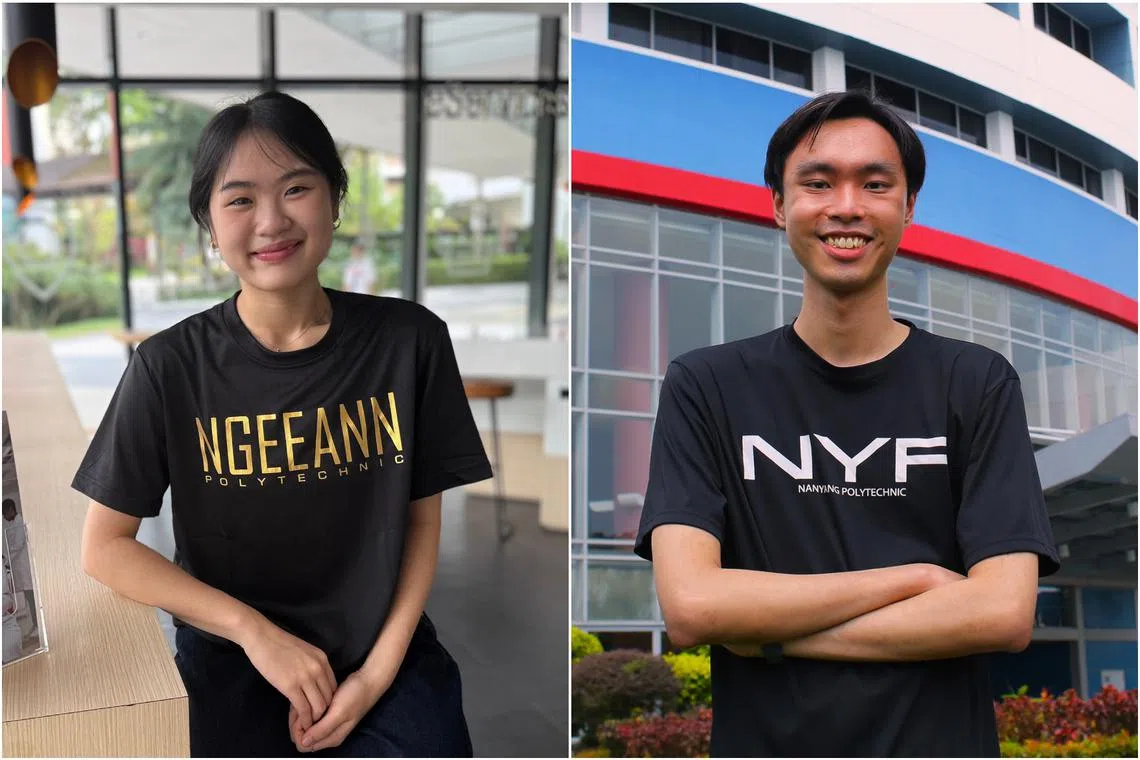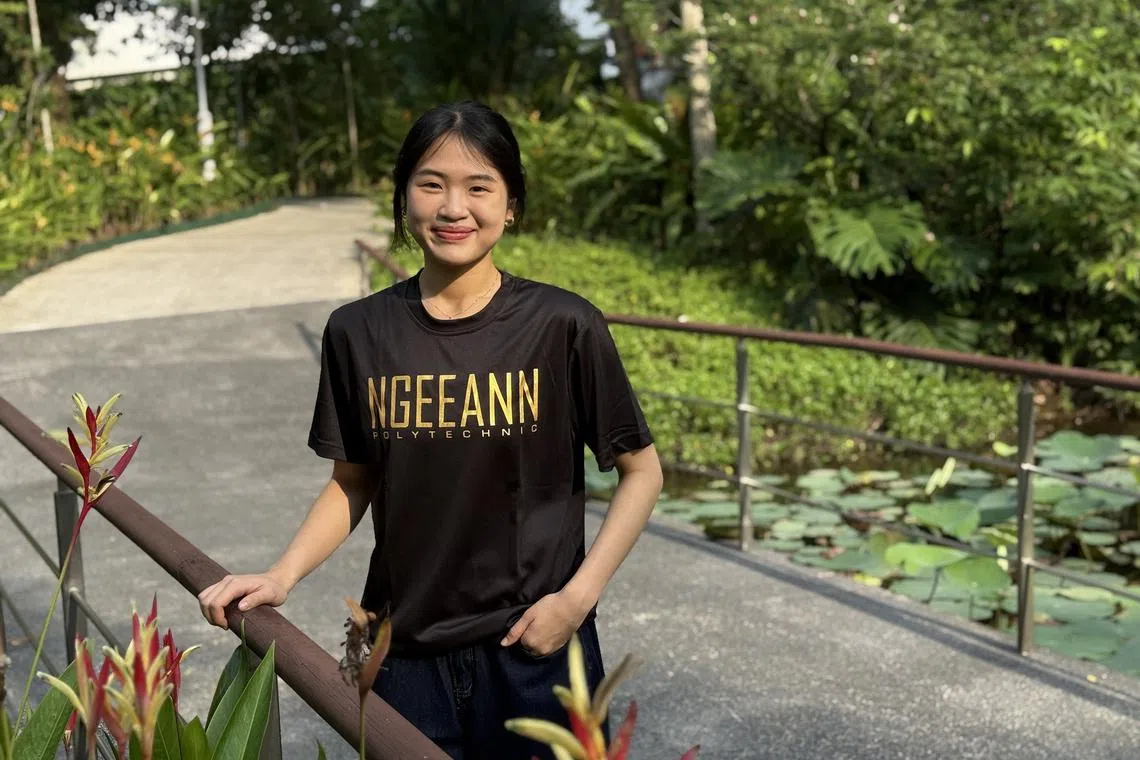About 6% to 7% of Integrated Programme students leave before completing six years: MOE
Sign up now: Get tips on how to help your child succeed

Former Integrated Programme students Tan Zhi En (left) and Kang Wen Yu.
PHOTOS: NGEE ANN POLYTECHNIC, NYP
Follow topic:
- Some Integrated Programme students switch to O-levels, polytechnics, or overseas schools due to academic pressure or differing learning preferences.
- Demand for IP remains high, with about 4,300 applying in 2024's Secondary 1 posting exercise, despite some students leaving.
- MOE says that IP suits self-directed learners; O-levels may better suit those preferring structured learning with clear milestones.
AI generated
Singapore – At the end of the year, about 4,000 PSLE pupils will celebrate winning a coveted place in the Integrated Programme (IP).
But some students already in the scheme will switch to the O-level route or make a quiet exit to polytechnics, other junior colleges and private schools in Singapore or overseas.
In response to queries from The Straits Times, the Ministry of Education (MOE) said that around 6 per cent to 7 per cent of the IP cohorts that graduated in 2022, 2023 and 2024 left before the six years were up. This translates to about 240 students in a cohort of 4,000.
IP students skip the O levels and proceed directly to the A levels or International Baccalaureate. They are expected to learn in an independent way, without having to prepare for two major exams in six years.
Of the students who leave, MOE said, about half transfer to the O-level route or join a polytechnic. Some move to other junior colleges, which, according to two students interviewed, suit them better and are less pressurising.
Others interviewed headed overseas or enrolled in international schools or private schools such as the Singapore Institute of Management to take up degree or foundation programmes that will enable them to transfer to degree studies at British or Australian universities.
Those who opted for the O-level route mostly transferred to the track within the same school, unless it was not available. Those transferring to polytechnics did so when they were in Secondary 4, or in the first year of junior college.
MOE figures show that demand for the IP remains strong, with about 7,000 Primary 6 pupils applying to the IP track through the Direct School Admission (DSA) scheme in mid-2024.
When asked how many applied after the release of the PSLE results in November, the ministry said that in 2024, about 4,300 applied for the IP track in the Secondary 1 posting exercise. Every year, several students who apply for places through the DSA also try again for a place later in the year through the posting exercise.
Students who left the IP said that although they were initially happy to have been selected for the programme, they soon discovered that they were not suited for it.
One of them was a Raffles Institution (RI) student who did not want to be named. He said he was thrilled when he made it to the “No. 1 secondary school in Singapore” – as his parents called RI.
“By Secondary 3, I was drifting and not really focused on my studies,” he said.
“It took a while before my parents agreed to let me move to another school to do the O levels. I needed to get away from my school, as I felt disappointed that I couldn’t hack it there.”
Two students who are now pursuing diploma courses at polytechnics said they, too, felt that the IP did not suit them.
Ngee Ann Polytechnic student Tan Zhi En, 18, left River Valley High in JC1 despite scoring a string of As in her Secondary 4 exams.

Ngee Ann Poly student Tan Zhi En left River Valley High to study biomedical sciences.
PHOTO: NGEE ANN POLYTECHNIC
“I found it all very academic-focused and my peers were already deciding between law, medicine or accountancy, while I wanted to explore some more,” she said.
“My stint at a vet practice made me want to explore biomedical sciences further, but not by taking up subjects such as biology for the A levels. I realised that I liked learning by doing, so that’s when I decided to head to Ngee Ann Poly to study biomedical science.”
Now, while maintaining an almost perfect grade point average, Ms Tan has been chosen for a research programme at Singapore General Hospital. “I made the change, although some dissuaded me, including my dad and teachers,” she said, adding that she hopes to pursue medicine overseas.
Nanyang Polytechnic (NYP) student Kang Wen Yu, 20, said he started having second thoughts about being in the IP at Catholic High School in Secondary 3, when he had to take a few months off because of health issues.
“I was worried that I could not keep up with my schoolwork. Besides, I wasn’t really enjoying all the academic subjects, and it was all too pressurising. I also realised that I enjoyed the graphics and computing course I took up online when I was on MC at home.”
But it took another two years before he finally decided to make the switch to NYP, because people around him said that leaving the prestigious programme was the wrong move.

NYP Kang Wen Yu said he started having second thoughts about being in the IP at Catholic High School in Secondary 3.
PHOTO: NYP
Mr Samuel Seah, one of the co-founders of Aspire Hub Education, estimates that 30 per cent to 40 per cent of parents who send their children to his 14 tuition centres around the island are aiming for an IP school for their child, although the programme takes in only about 10 per cent of a PSLE cohort.
“When we recognise that a child may not be suited for an IP school, we do talk to the parents during parent-teacher meetings,” he said.
“We tell them that the ‘big fish in a little pond effect’ is very real and applies to some kids, where they do well when they are a top student in a school, but not when they are average in a selective school. It affects their confidence and self-esteem, and they end up doing poorly.”
Mr Seah echoed the comments by two teachers from an IP school, who said that it is not the most desirable route for everyone. Nor is it the only path to success.
The teachers, who did not want to be named, said those who fail to thrive in the IP are not just students who landed a place because of their sporting or co-curricular achievements. Some had scores that put them in the top 10 per cent of their PSLE cohort, and a handful were from the Gifted Education Programme.
“Ultimately, the IP benefits students who are independent learners and can benefit from the self-directed learning environment that IP schools provide,” a veteran IP teacher said.
MOE said that parents and students should consider how well the schools’ programmes and learning activities match the individual’s strengths, interests, learning dispositions and aspirations.
“Generally, the IP is more suitable for self-directed and independent learners, while students who prefer structured learning with clear milestones may thrive better in the O-level track,” it said.
Both tracks offer opportunities for holistic development and a strong foundation for tertiary education, it added.


